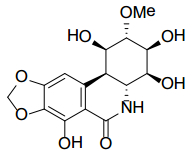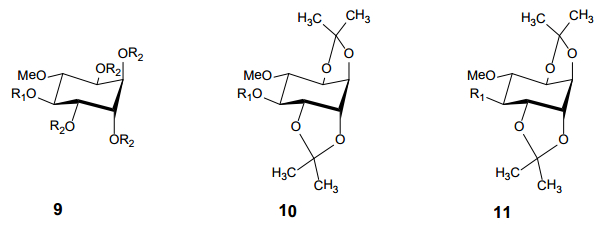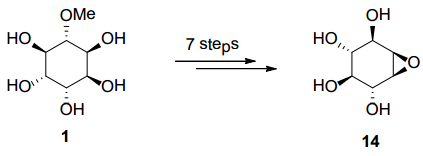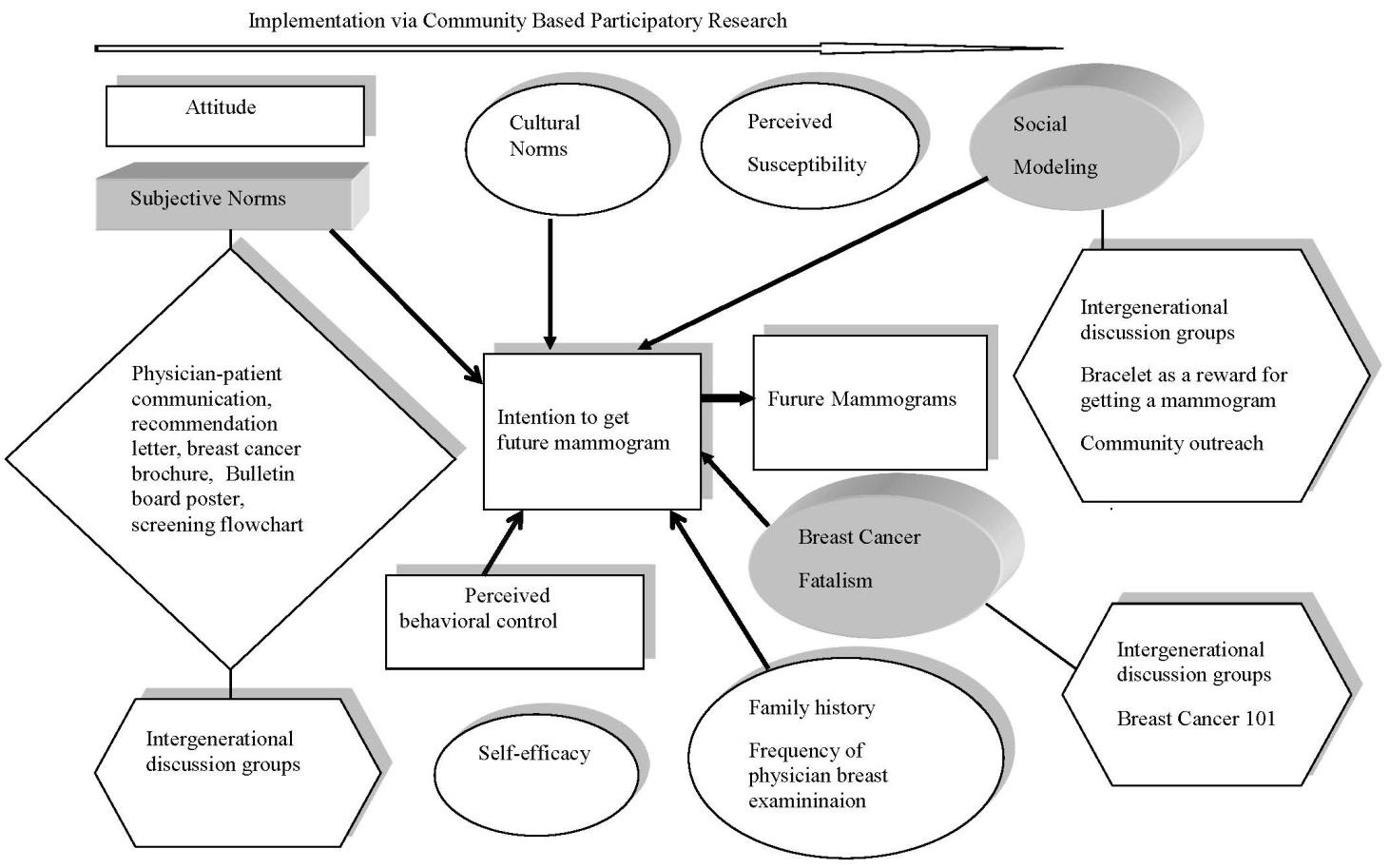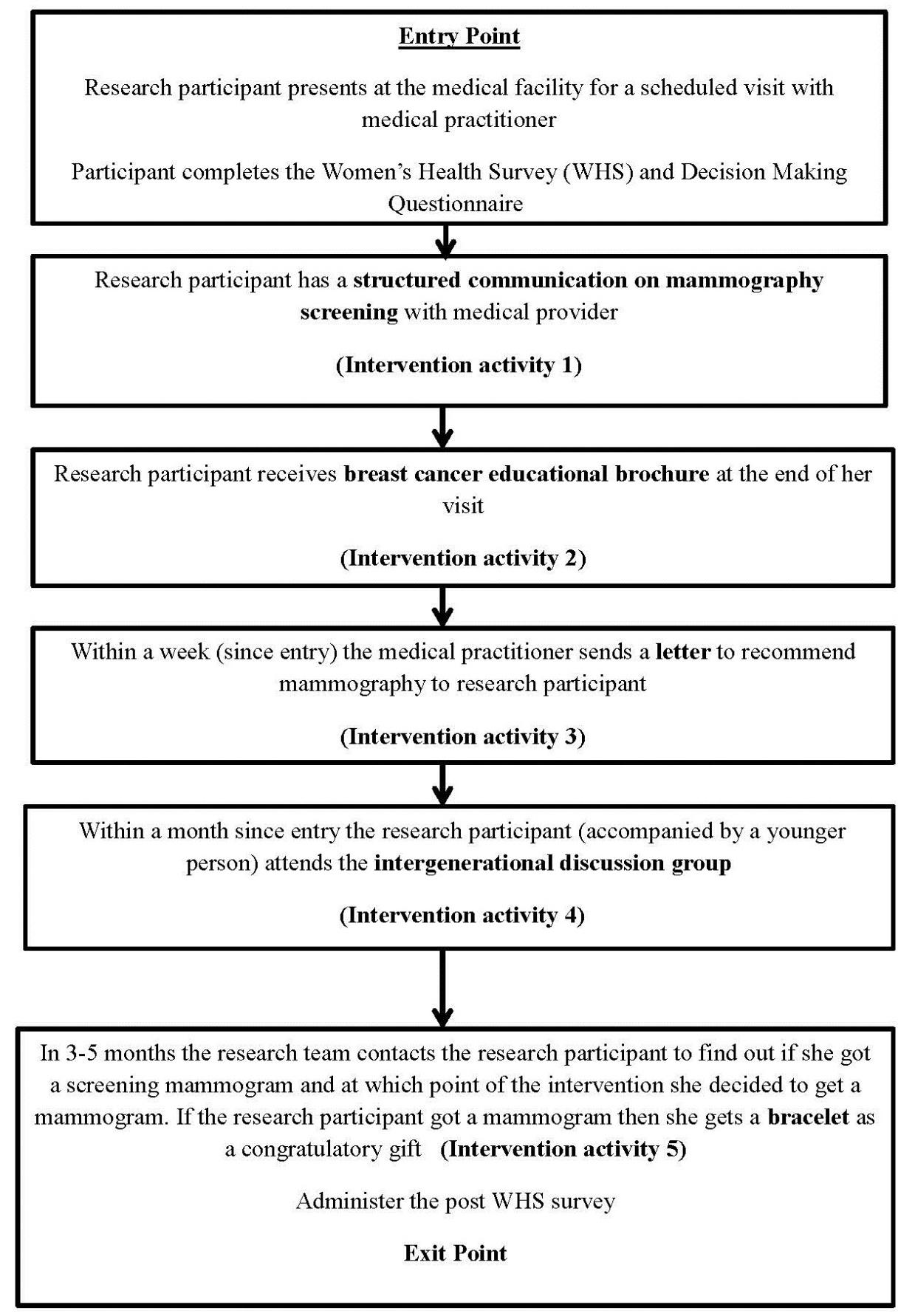1. Structure and properties
1.1. Structure
D-pinitol (Figure 1) is a natural compound, whose name etymologically derives from "pine", as it was first isolated and structurally characterized from the pine tree. D-pinitol is a member of the methylated inositol family (cyclitols), that are cyclohexane-1, 2, 3, 4, 5, 6-hexaols existing as nine isomers according to the different configurations of the hydroxyl groups. However, only 5 inositols are naturally occurring: myo-, chiro-, scyllo-, muco-, neo-inositol [1]. More specifically, D-pinitol is the 3-O-methyl ether of D-chiro-inositol [2], that is to say the (1R, 2S, 3R, 4S, 5S, 6S)-6-methoxycyclohexane-1, 2, 3, 4, 5-pentaol [3,4,5,6,7,8].
1.2. Physico-chemical properties
D-pinitol exists as a white to off-white solid with a melting point of 186–187 ºC [9]. This compound is very soluble in water and slightly soluble in ethanol. Its specific rotation in water is [ᾳ]D = + 65º (c 0.4, H2O) [9,10]; [ᾳ]D = + 67º (c 0.30, H2O). Spectroscopic data have been reported previously [8,11]. Comprehensive characterization of D-Pinitol and cyclitols in general, with information about the sample preparation, extraction, purification and analytic methods can be revised in Al-Suod et al. [12] and references therein.
2. Sources
2.1. Natural abundance
D-pinitol and cyclitols as a group can be commonly found in most plants [12,13,14]. However, members of the Leguminosae family are the major natural source of this compound [11,13,15,16]. Within them, Ceratonia siliqua L. (Carob), an evergreen tree that contains much higher amounts of D-pinitol than any other legume [1,14,17]. Other plant families from which has been isolated are: Pinaceae, Asteraceae, Caryophyllaceae, Zygophyllaceae, Cupressaceae, Aristolochiaceae, Sapindaceae [11,18]. Worthy to note, the carob tree has been growing since antiquity in the Mediterranean area, where it is recognized because of its environmental benefits, such as for example that it can fix three times more CO2 than other common woody crops with half of the water requirements, at the time that it is resistant to eroded soils and fires [19]. Unfortunately, carob trees have been mainly used traditionally to obtain LBG (thickener E410) from the seeds, that account only for a 10% of the pod's weight, but the emergence of cheaper substitutes for LBG, such as guar or xantam gum, made the carob tree cultivation no longer profitable in the EU. As a consequence, crops have been abandoned. The promotion of the carob tree by exploiting the potential of this agro-food product would strength the competitiveness of the economies in rural areas, preventing population from abandoning these areas. Notwithstanding the concentration of D-pinitol in carob pods varies significantly depending on the variety and location of the tree, from 5% [20] to more than 10% in some Spanish varieties [1], carob pods are by difference their most cost-effective natural source [21,22,23]. The main described function in plants is as an osmolyte that improves the tolerance to abiotic stress such as drought or high temperatures [24,25].
2.2. Synthetic D-pinitol
Even if D-pinitol is naturally derived from D-chiro-inositol, pertaining to the family of inositols, a few preparative methods have been reported for the synthesis, through the combination of chemical and biochemical transformations [26,27,28,29,30], as well as by means of a total synthesis [31]. Thus, the first method was reported by Ley et al. [30], who accomplished the preparation of D-pinitol in 35% overall yield starting from benzene (compound 2 in Scheme 1), involving the microbial oxidation of this compound to (1R, 2S)-cyclohexa-3, 5-diene-1, 2-diol (3) followed by 5 synthetic steps (see Ley et al., 1987 for details). Later, these authors improved the strategy to achieve a 49% overall yield [29].
Additionally, Hudlicky et al. [26,27] reported a similar methodology starting from microbial oxidation of bromobencene (compound 4 in Scheme 2) to (1S, 2S)-3-bromocyclohexa-3, 5-diene-1, 2-diol (5). Later on, Aceña et al. [31] reported the total synthesis of D-pinitol starting from chiral accessible building blocks in seven synthetic steps with a 10% yield.
3. Health promoting effects of D-pinitol
D-pinitol is thought to be the active component of the traditional remedy Talisa patra (called Morinda in Hindi), derived from the plant Abies pindrow (Pinaceae, Pindrow Fir), which has been used for centuries in folk medicine, also described in Ayurveda for various respiratory and inflammatory ailments [32]. Moreover, it has been identified as an active principle in soy foods and legumes [24,25]. Nevertheless, as it would be extensively described hereinafter, this natural inositol has a much higher pharmacological potential because of its multifunctional properties (e.g., inositol phosphoglycans generated from lipid and/or protein precursors in cell membranes act as insulin-like factors in vitro and in vivo) [24,33,34,35,36,37].
3.1. Anticancer
Breast cancer represents an enormous public health problem nowadays. Thus, for example, it is the principal cause of mortality and the most frequent cancer in women in the U.S. [38,39,40,41]. On the other hand, prostate cancer that is at epidemic proportions, is particularly dangerous because it has a very high tendency to metastasize, particularly to the bone [24,42,43,44]. It is known that cancer metastasis is in the origin of most tumour progressions and consequently the majority of patients suffering cancer finally die because of this reason [24]. More specifically, it has been demonstrated that prostate cancer expands to distant organs including the liver, bladder, bone, lungs, spine and lymph nodes [45,46,47]. Fortunately, a very important source of potentially efficient chemotherapeutic compounds against cancer can be found in natural products [48]. In fact, through an extant of epidemiological studies it has been proved that a considerable lesser risk of cancer exists in those people who regularly ingest fruits and vegetables, which could be attributed to their concentration of combined phytochemicals. Obviously, the prevention of cancer through the implementation of an equilibrated diet is a promising opportunity aiming to reduce its incidence [49,50]. In this context, the National Cancer Institute (NCI) has highlighted a number of foods for which there are evidences of a reduced risk of suffering cancer if incorporated in the regular diet, including plant-derived foods such as soybean (51a and b).
It has been discovered that D-pinitol reduces the progress and attack of certain prostate cancer cells in vitro at non-cytotoxic concentrations [24,45]. Also, D-pinitol has demonstrated preventive efficacy against breast cancer induced in rats [52,53] as well as tumour-growth inhibitory activity through the modulation of the balance between inflammatory cytokines, hormones, tumour markers, lipids and other biochemical processes [38,39], finally resulting in the growth retardation of tumour cells (see also [42]). Moreover, D-pinitol has a proven protective effect against the dangerous consequences of oxidative stress suffered by the hepatic and renal tissues in breast cancer [54,55,56]. Thus, the elevated levels of total cholesterol, free cholesterol, phospholipids, triglycerides and free fatty acids observed in rats with cancer became significantly at almost normal levels after administration of D-pinitol [39]. It is worth to mention the work of Song et al. [57], at the Chungbuk National University in South Korea, patenting the use of D-pinitol for cancer treatment and prevention of cancer relapse.
The mode of action of the D-pinitol to exert its anti-cancer biological activityhas been suggested to be the active blocking of the Nuclear Factor kappa B (NF-ⱪB) pathway, a transcription factor inactively present in the cytoplasm that is activated through its reallocation to the nucleus by an important number of carcinogens and inflammatory agents [58]. The NF-ⱪB is a major target nowadays for the development of new, more potent and less noxious, cancer drugs. Its blockage is a potential strategy because it leads to the inhibition of TNF-induced cell invasion and to the down-regulation of a few gene products that are capable to prevent apoptosis and promote inflammation and tumour metastasis [32,39,59]. More specifically, as NF-ⱪB is involved in the regulation of several genes that are related with invasion in cancer cells, such as the Matrix Metalloproteinase MMP-9 [60] capable to degrade components of the extracellular matrix facilitating the invasion of malignant cells, targeting the NF-ⱪB pathway is as a prospective strategy to suppress the tumour invasion that is mediated through MMP-9 [45]. Specifically, Jayasooriya et al. [45] demonstrated that D-pinitol is capable to inhibit certain prostate cancer cells that act by means of TNF-ᾳ-induced invasion, through the amelioration of the MMP-9 expression and the resulting invasion with repression of the NF-ⱪB pathway.
In addition, Lin et al. [24,61] found that D-pinitol diminishes in a dose-dependent manner the Focal adhesion kinase (FAK protein) phosphorylation, precisely this is of high interest for treating cancer because FAK is involved in tumour migration and invasion [24,62,63]. Specifically, it has been proven that D-pinitol inhibits cell motility in human prostate cancer cells via the FAK/c-Src signalling pathway [24]. Taking into account that an inefficient degradation of lipids is associated to the development of certain types of cancer [39,64,65], Rengarajan et al. demonstrated that D-pinitol is capable to prevent the elevation of lipid peroxidation, thus resulting in the protection of the cell membrane against mammary carcinogenesis [39,54,66].
3.2. Anti-diabetic
Non-insulin dependent (Type 2) Diabetes Mellitus (T2DM) is a chronic disease with associated comorbidities. Nowadays, it is estimated that every year 6.8% of the world's population die due to complications related with this illness [67,68]. Even more, if we do not adopt the adequate precautions, the prevalence of this malignancy is expected to increase worldwide from 171 million in 2000 to 366 million in 2030. About 90% of the diabetes cases are T2DM [69], is considered one of the most complicated worldwide epidemics which has taken place in the recent decades [33,70]. The T2DM is characterized by levels of blood glucose that are abnormally high due to a deficiency in the secretion of insulin, or maybe also associated to other insulin receptor or post-receptor events, leading to disequilibrium in the metabolisms of carbohydrates, proteins and fats. Additionally, this perturbed metabolic status directs the progression and aggravation of oxidative stress through a series of phenomena such as the glucose autoxidation, protein glycation and the formation of the adverse advanced-glycation-end products (AGEs), resulting in the development of other important secondary diabetic complications such as nephropathy, retinopathy, neuropathy, macro and microvascular damages and increased risk of coronary heart disease [71,72]. As Gao et al. pointed out, it is of the greatest importance to find appropriate and better treatments and preventive strategies for this pathology [33] that allow a more effective control of blood glucose, as well as a reduction of the oxidative stress and the normalization of some disturbances occurring in the lipid metabolism that predispose patients to cardiovascular complications [72]. Additionally, it is worthy to note here the opinion of an expert committee on diabetes mellitus at the World Health Organization (WHO) nearly forty years ago, of prioritizing the evaluation of the effectiveness of plants, and natural compounds derived from them, in this condition [73].
Regarding to this, it can be pointed out that D-pinitol is an active principle of the antidiabetic plant Bougainvillea spectabilis, traditionally known because of its insulin-like effects [74,75]. Also, different plant extracts containing D-pinitol have demonstrated efficacy in animals and humans in the amelioration of a number of metabolic disturbances originated by diabetes mellitus, such as soybean, buckwheat, tartary buckwheat or carob tree extracts, to name a few [76]. Therefore, the insulinomimetic properties of this inositol and its capability to reduce hyperglycaemia as well as to regulate other metabolic complications associated to T2DM, have been extensively demonstrated in vivo and in human subjects [see 26, 33, 71, 72, 74, 76-93 and references therein]. The efficacy of D-pinitol has been proved different models studying the postprandial response of glucose and the modifications of the lipid profile in diabetic rats and monkeys, and in human subjects [72,74,81,82,84,85,89]. Accordingly, Kim et al. postulated that a defective metabolism of D-chiro-inositol, the parent compound of D-pinitol, could be in the origin of impaired insulin action and the development of insulin resistance in Type 2 Diabetes [89]. Moreover, Sivakumar et al. [71,78,79] established that D-pinitol is capable to attenuate the oxidative stress suffered by Sreptozotocin-induced diabetic rats, through the reduction of lipid peroxidation and the amelioration of the prevalence in pro-inflammatory factors, successfully leading to the protection of hepatic, kidney and pancreatic tissues. Also, Nascimento et al. [77], similarly corroborated the improvement of metabolic descriptors related to the kidney function in type 2 diabetic patients administered with D-pinitol. But the usefulness of this compound is not limited to the medical context, as very positive effects in decreasing hyperglycaemia and circulating insulin levels have been demonstrated also in healthy subjects [94], pointing out to the convenience of considering D-pinitol as a beneficial dietary supplement.
As a result of the growing interest on D-pinitol for the treatment of diabetes mellitus and for the pathologies associated to this disease, there are a number of patents protecting these potential exploitations. For example, an international patent was developed by Rademacher Group Ltd., [95] to defend uses of D-pinitol as an equivalent of inositol phosphoglycans, for different pathologic conditions (e.g., T2DM and obesity). Additionally, specific uses of compositions containing D-pinitol for treating T2DM and related health complications were claimed in USA., by the University of Washington [96] and by the University of Virginia [97], as well as in Korea by Solgent Co. Ltd. [98,99] and by Amicogen Co. Ltd. [100].
Dealing with the biological mechanisms by which D-pinitol regulates the metabolic complications associated to T2DM, it has been postulated that it acts in a pathway following the insulin action after the glucose absorption [74], as it has been demonstrated that the ability of D-pinitol to reduce hyperglycaemia is not consequence of increased insulin concentrations neither of augmentation of the insulin activity, concluding that this inositol exerts an insulin-like effect on glucose transport independently of insulin, acting downstream in the insulin signalling pathway [82,89].
Moreover, Dang et al. [86] demonstrated that the effectiveness of D-pinitol is related to the ability of this compound to stimulate the mobility of Glucose Transporter 4 (GLUT4), which according to its sensitivity to insulin, plays an important role in the regulation of glucose transportation to the skeletal muscle and the adipose tissue. PI3K/Akt signalling pathway is involved in this process through a protein phosphorylation cascade. Therefore, D-pinitol stimulates a reduction of plasma glucose levels under certain conditions of high glucose levels. In concordance, Gao et al. [33] pointed out that the amelioration of insulin resistance in T2DM promoted by D-pinitol occurred through the PI3K/Akt pathway, similarly to other inositol phosphates, implicating the PI3Kp85 and PI3Kp110 subunits [101,102,103]. Thus, the PI3K/Akt pathway that is implicated in a number of human diseases including cancer, diabetes, cardiovascular and neurological diseases [104], is regulated by D-pinitol, resulting in an effective reduction of the concentration of blood glucose through promotion of glycogen synthesis [33].
On the other hand, the capacity of D-pinitol to normalize other metabolic complications associated to T2DM (e.g., lipid profiles, attenuation of oxidative stress with reduction of lipid peroxidation, amelioration of pro-inflammatory factors as well as protection of hepatic, kidney and pancreatic tissues) is directly related with the normalization of blood glucose levels, leading to lesser glucose autoxidation processes, but also with the intrinsic free radical scavenging potential and antioxidant nature of D-pinitol [71]. Additionally, it is worth to mention that D-pinitol has the capacity to suppress the NF-ⱪB pathway, regulating the oxidative stress provoked as a consequence of NF-ⱪB activation during abnormal hyperglycaemic states, also regulating the elevation of proinflammatory cytokines (i.e., TNF-ᾳ, IL-1β and IL-6). As Yu et al. pointed out [87] (see also section 3.1). D-pinitol might be a good candidate for treating inflammatory bone-related diseases and secondary osteoporosis in T2DM.
3.3. Antioxidant
Oxidative stress is considered a pathologic state in which the equilibrium between the activity of oxidants and antioxidants in the body is perturbed, in favour of the oxidants. That is to say, oxidants are present in the body under normal conditions, formed for example as products of aerobic metabolism, but under certain abnormal situations they can be produced with a very high elevated rate which can't be compensated. During the last decades, oxidative stress has been one of the most important topics for researchers of diverse areas all over the world (e.g., medicine, biochemistry or food technology) [105], due to the close relationship that exists between oxidative stress and altered immune functions, increases in the incidence of autoimmune diseases, higher susceptibility to infections, and accentuated prevalence of carcinogenesis phenomena. Additionally, there exists an intimate connection between oxidative stress and aging. At the cellular level, redox homeostasis is partly maintained by means of endogenous enzymatic and non-enzymatic antioxidant mechanisms, which take place within the cytoplasm and in a diversity of cell organelles. Natural food-derived antioxidant compounds have received major attention in the last years because of its capacity to contribute to the normalization of the cellular redox status in the organism with little or negligible side effects.
Sivakumar et al. recently demonstrated the beneficial effect of D-pinitol against oxidative stress [78,79], which could be attributed to its free radical scavenging capacity. Additionally, different uses of D-pinitol, and derived compositions, have been protected considering this antioxidant potential [100,106].
3.4. Hepatoprotective
As it has been mentioned above, D-pinitol exerts a protective effect of the hepatic, kidney and pancreatic tissues against oxidative stress [71,78,79]. Special mention is given here to the hepatoprotective action because of the importance of the liver as a vital organ, with critical functions such as for example the detoxification of the body from hazardous substances. Unfortunately, a number of reactive species, including free radicals, can damage the liver leading to jaundice, cirrhosis or fatty liver, to name a few. Additionally, viral hepatitis is considered a major health problem throughout the world [107].
Zhou et al. [108] evidenced that D-pinitol exerts a protective effect against human viral hepatitis caused by D-galactosamine (GalN) in rat model. More specifically, this inositol improves the liver function by lowering the levels of certain serum aminotransferases, such as aspartate transaminase (AST) and alanine transaminase (ALT), as well as of the inflammatory cytokine TNF-ᾳ. Consistently, Choi et al. [37] demonstrated that the regular administration of D-pinitol protects against the hepatotoxic effects of a hypercholesterolemic diet at least in part, by the antioxidant nature of D-pinitol and its capacity to activate cell antioxidant enzyme systems, even if this is not well understood yet [35]. In line with these results, Amicogen Inc. (USA) patented the exploitation of D-pinitol and formulas containing this compound, for protecting the liver [106].
3.5. Immuno-suppressor
A proper functioning of the immune system is of vital importance, because a prolonged debilitation can be the cause of recurrent infections or, for example, of a higher risk of cancer [39,109,110,111]. Immunodeficiency may occur as a result of certain diseases (e.g., HIV/AIDS), or it can be induced if desirable (e.g., to avoid transplantation rejections). On the other hand, a hyperactive immune system leads to serious health problems or autoimmune diseases such as rheumatoid arthritis, type 1 diabetes or lupus erythematosus, to name a few. Asthma, chronic inflammatory processes and a propensity for allergic responses are also the manifestation of a hyperactive immune system [112]. T-lymphocites Th1 and Th2 play a major role in immunity and so, several immunological diseases are associated with the deregulation of these cytokines. Therefore, the modulation of the Th1/Th2 balance has become a new paradigm in immunomodulatory therapy [113]. Immunosuppressive drugs (e.g., cyclosporine, cyclophosphamide, tacrolimus, mycophenolate mofetil or rapamycin) are chemical compounds used for organ transplantation and to treat some serious autoimmune diseases. However, they are very problematic as their efficacy depends on the particular differences between subjects, with a very high concomitant risk of therapeutic failure [113].
The immunomodulatory capacity of D-pinitol, thoroughly investigated for treating pathologies such as asthma, chronic inflammation, rheumatoid arthritis or multiple sclerosis [113,114,115,116], has demonstrated to be a promising strategy to attain a more equilibrated immunological system with negligible side effects. Thus, D-pinitol administration in rats showed very good anti-inflammatory activity, demonstrated by means of the adequate models of chronic inflammation, such as the induction with carrageenan and cotton pellets [114], as well as a remarkable inhibitory capacity of asthma [115]. Dealing with the mechanism by which D-pinitol exerts its immunomodulatory activity, it seems clear that this bioactive compound acts as a regulator of the Th1/Th2 balance [113,115,116]. Nevertheless, some contradictory results arise after a scrupulous analysis of the literature. Thus, Lee et al. [115,116] found that D-pinitol reduced the increased levels of the Th2 cytokine IL-4, a result corroborated by Chauhan et al. [113]. Contrary, Lee et al. [115] asserted that simultaneously, an increase in the production of the Th1 cytokine IFN-γ occurred, while Chauhan et al. [113] claimed exactly the opposite, a reduction of this precise cytokine caused by D-pinitol consumption. Moreover, the regulation of Th1/Th2 balance might take place, according to Lee et al. [115], via the suppression of GATA-3 and increase of T-bet expression.
In order to summarize the findings about the health-promoting potential of D-pinitol, we could highlight its high potency in the modulation of the immunological system responses with potentially less side effects than the currently available synthetic drugs such as cyclophosphamide. This inositol is capable to regulate the production of Th1/Th2 cytokines, offering new potential therapeutic targets for the prevention and management of autoimmune and related diseases [113,115,116]. Taking this into consideration, has prompted the patenting of the immunosuppressive activity of certain formulations containing D-pinitol [117] to prevent and treat inflammatory diseases [118].
3.6. Inhibitory action of osteoclastogenesis (anti-osteoporosis)
Bone is a complex tissue made of different types of cells which are continuously experiencing a range of equilibrated processes of formation and resorption. Osteoporosis results from an imbalance between these processes of bone resorption and bone formation leading to a net bone lost. This imbalance can be originated as a consequence of several conditions such as hormonal disturbances or certain diseases or medications (e.g., corticosteroids or anti-epileptic agents) [34,119]. Drugs for treating osteoporosis (e.g., bisphosphonates, calcitonin and oestrogen) act by inhibiting the function of osteoclasts that are responsible for bone resorption [34,120]. Unfortunately, these drugs have limited success on recovering bone mass (maximum 2% per year) [34]. Inflammatory cytokines (e.g., tumour necrosis factor, TNF) play a major role in osteoclastogenesis, favouring bone resorption associated with osteoporosis. Indeed, receptor activator of the NF-kB Ligand (RANKL), a protein member of the TNF superfamily, contributes to control bone regeneration processes and so, suppressing RANKL signalling pathway is a potential strategy to suppress bone loss [34]. In this concern, Liu et al. [34] showed that D-pinitol is capable to inhibit the formation of osteoclasts induced by RANKL. Specifically, this inositol exerts this effect through the p38/JNK and NF-ⱪB pathways. In conclusion, D-pinitol has potential to be used for treatment and prevention of osteoporosis. Taking this into account, Solgent Co protected a composition for prevention or treatment of bone metabolism disorders comprising D-pinitol as an active ingredient [121].
3.7. Anti-aging
Aging can be viewed as an accumulation of changes over time, accompanied with a functional and reproductive decline that is associated with an increased mortality [122,123]. Dietary restriction (DR), the continuous reduction of nutrients without malnutrition, has demonstrated to be an effective strategy [123,124]. However, it is not obviously a generally applicable therapeutic strategy. D-pinitol is one of a few compounds known to be capable to mimic DR. Thus, Hada et al. [123] showed that D-pinitol treatment considerably extended life span of Drosophila melanogaster, reducing oxidative stress and improving health, with evident benefits in locomotion. Worth noting, no reduction in fecundity was observed. These authors pointed out a deactivation of the insulin/IGF-1 signaling (IIS) pathway as the most probable mechanism [125,126]. Specifically, it was postulated that supplementation of D-pinitol may reduce the cellular levels of the intracellular messenger phosphatidylinositol (3, 4, 5)-triphosphate (PIP3), a compound structurally related to D-pinitol that is capable to inhibit dFOXO (single Drosophila melanogaster forkhead box O transcription factor). Then, as dFOXO plays important functions in cell growth, proliferation, differentiation and longevity, D-pinitol facilitates its activation through reduction of its inhibitor PIP3. Indeed, Hada et al. [123,127] demonstrated that the activation of dFOXO by D-pinitol was acquired by means of the S6K and JNK signalling pathways. Furthermore, a reduction of the inflammatory response, closely related to aging, may contribute to the anti-aging effect of D-pinitol, through the biological mechanisms previously explained in detail (see section 2.5, immunosuppressor effect of D-Pinitol). Therefore, it was concluded that D-pinitol has great potential to be used as a functional ingredient with anti-aging properties [123]. Consequently, the National Institute of Advanced Industrial Science and Technology (AIST) associated with Tsujiko Co. Ltd., in Japan [128], as well as at Dermalab Co. Ltd., in Korea [129,130] have protected compositions containing D-pinitol with anti-aging properties.
3.8. Creatine retention stimulant
Creatine is a natural organic compound that exists in vertebrates with the main function to promote the conversion of adenosine diphosphate (ADP) to adenosine triphosphate (ATP), the energy currency of cells, primarily in muscle and brain tissues [131]. It is produced in the organism, predominately in the liver, kidneys, pancreas, and complemented through the diet [132]. Additionally, creatine is one of the most consumed natural supplements with the aim to improve performance in sport. However, improvements in strength and resistance have been shown to be more or less advantageous depending on the individual capabilities to storage it, a condition mediated by insulin. Notably, co-ingestion of creatine with large amounts of sugars, with or without proteins, has shown to improve creatine uptake and retention, but the problem with this strategy is that great excesses of calories are needed to attain the desired effect.
Co-ingestion of D-pinitol and creatine seems to improve the retention of creatine [133]. However, some controversy exists as it has been explicitly manifested in relevant literature. Thus, Cooke and Cribb [134] pointed out in a current comprehensive book about sports nutrition that further research is necessary to attain a clear conclusion, and similar arguments where emphasized by Chantler and Smit [135] in a recent guide for nutritional supplements-supplements in sport, exercise and health: An A-Z Guide. The foundations for such allegations (see also the original works [133,136]) are briefly discussed hereinafter. On the one hand, Greenwood et al. [133] showed that low doses of D-pinitol (1 g day–1) administered with creatine resulted in an increase of the whole body creatine retention, comparable to previously reported enhancements through co-ingestion of creatine with sugars. Nevertheless, Kerksick et al. [136] proved that co-administration of higher doses of D-pinitol (20 g day–1) resulted in the absence of a significant improvement of creatine retention nor in any other physiological benefit.
Taking into account that insulin facilitates creatine uptake, insulin-mimetic properties of D-pinitol have been alleged as the cause of the benefit of D-pinitol supplementation at low doses on creatine retention [133]. Notwithstanding more profound investigations are recommended, the potential applicability of D-pinitol to improve performance in sports has generated a large number of patents. Briefly, two international patents [137,138] and various from different nationalities [139,140,141,142,143,144,145], are claiming about the advantages of this compound on relation to strength, endurance, muscle growth, performance in sports and similar effects. For example, Humanetics Corporation [137] protected worldwide formulations combining D-pinitol and creatine, or an active derivative thereof, to improve muscle performance and to enhance muscle hypertrophy, while New Nitro Formulations Ltd. [138], protected D-pinitol and compositions thereof to enhance skeletal muscle growth, reduce skeletal muscle loss and increase the energy supply to the skeletal muscle.
3.9. Ameliorative of Alzheimer's disease
Alzheimer's disease is a serious neurodegenerative condition that provokes a progressive deteriorated status of dementia in which synapses are lost [146,147]. Unfortunately, nowadays this illness, that affects 13% of people older than 65 in developing countries, is untreatable and fatal [146]. A number of strategies to alleviate Alzheimer's disease have been designed according to the plausible cause of the illness [146]. Between them, compounds directed to reduce beta Amyloid (Aβ) peptide formation and to facilitate Aβ plaques dissolution are of principal interest, as it is the case for D-pinitol [146,147], a molecule with a high potential for treating this disease [146,147,148,149,150,151,152,153,154,155,156].
D-pinitol has demonstrated improving activity in preclinical models of Alzheimer's disease, making this compound an excellent candidate as a therapeutic agent for this malignancy. Moreover, Phase-Ⅱ studies have been carried out showing good tolerability and stabilization of cognition (clinical trials NCT00470418 [157a] and NCT01928420 [157b]). Thus, D-pinitol, also known as NIC5-15 in clinical trials, is considered a selective γ-secretase modulator (SGSM) that is the general denomination used to identify those molecules that are selectively capable to block the amyloid precursor protein (APP) without interfering with other signalling pathways. Concretely, D-pinitol is alleged to modulate γ-secretase and to reduce Aβ production, although these findings are still in a preliminary stage [146]. Pasinetti in the U.S.A. [154,155] and McLaurin in Europe [156] have patented compositions and uses of D-pinitol for treating Alzheimer's disease.
4. Synthetic D-pinitol derivatives
The access to D-pinitol derivatives is of great interest because of the remarkable biological properties of these compounds [2,5,95,96,158,159,160,161]. Early in 1989, Tegge and Ballau [161] described the synthesis of D-myo-inositol-1, 4, 5-triphosphate (6), a naturally occurring compound first isolated from bovine brain [161], starting from D-pinitol (1) through a complex route of 8 synthetic steps (see Scheme 3), with very poor overall yields [161,162].
More recently, Catelani et al. [5] with the aim to obtain biomimetic compounds of ᾳ-L-rhamnopyranose, a molecular unit present in many more complex bioactive saccharides, accomplished the stereoselective synthesis of 3, 5-di-O-benzyl-D-pinitol (compound 8 in Scheme 4) starting from the partially protected aldohexos-5-ulose (7), through a 6 steps synthetic route with moderate yield.
Using D-pinitol as a chiral building block, Li et al. [5,160] accomplished the total synthesis of (+)-Pancratistatin (Figure 2), an important naturally occurring alkaloid possessing growth inhibitory activity against certain in-vitro and in-vivo cancer cells.
Additionally, Bhat et al. [2] carried out the semi-synthesis of various selectively acylated D-pinitol derivatives (compounds 9, 10 and 11 in Figure 3), through biochemical and chemical transformations. Moreover, they evaluated their potential as inhibitors of TNF-ᾳ cytokine expression in human neutrophils, with positive results in some cases (Table 1).
Table 1. Inhibitory capacity of TNF-ᾳ expression by D-pinitol derivatives (compounds showing more than 50% inhibition can be considered as potent inhibitors; revised from Bhat et al., 2009).
| Compound |
R1 |
R2 |
Inhibitory capacity at 1 µg/mL |
Compound |
R1 |
Inhibitory capacity at 1 µg/mL |
| D-Pinitol |
H |
H |
30.03% |
10a |
H |
13.09% |
| 9a |
Acetyl- |
H |
2.28% |
10b |
Acetyl- |
42.58% |
| 9b |
Butanoyl- |
H |
8.36% |
10c |
Butanoyl- |
39.54% |
| 9c |
Propanoyl- |
H |
20.91% |
10d |
Propanoyl- |
32.14% |
| 9d |
Iso-butanoyl- |
H |
17.85% |
10e |
Iso-butanoyl- |
20.65% |
| 9e |
COCH3 |
= R1 |
33.46% |
10f |
All |
34.98% |
| 9f |
COCH2CH3 |
= R1 |
30.79% |
10g |
Me |
33.33% |
| 9g |
COCH2CH2CH3 |
= R1 |
52.47% |
10h |
Et |
38.40% |
| 9h |
COPh |
= R1 |
51.71% |
11a |
Cl |
37.64% |
| 9i |
All |
H |
29.65% |
11b |
= O |
50.57% |
| 9j |
Me |
H |
39.16% |
Compound |
Inhibitory capacity (%) at 10 µg/mL |
| 9k |
Et |
H |
36.50% |
Rolipram |
52.85% |
Additionally, Zhan and Lou [159] carried out the synthesis of azole nucleoside analogues of D-Pinitol (compounds 12 and 13 in Scheme 5), and evaluated their growth inhibitory potential for various human cancel cell lines of lung and bladder, with positive results in some cases as can be shown in Table 2.
Table 2. Synthetic azole nucleoside analogues (12, 13) of D-pinitol (1) and evaluation of their cytotoxicity in human lung and bladder cancer cell lines PG and T24 respectively (revised from Zhan and Lou, 2007).
| Compound |
R |
Yield (%) |
EC50(µM) |
|
|
|
PG |
T24 |
| 12a |
1H-1, 2, 4-triazol-1-yl |
74 |
11.3 |
78.5 |
| 12b |
1H-benzo[d][1, 2, 3]triazol-1-yl |
68 |
22.6 |
83.8 |
| 12c |
6-nitro-1H-indazol-1-yl |
66 |
> 100 |
> 100 |
| 12d/13a (ratio = 1.71) |
5-nitro-1H-indazol-1-yl |
62 |
> 100 |
> 100 |
| Sangivamycin |
– |
– |
0.012 |
0.008 |
Moreover, Falshaw et al. [158] accomplished the semi-synthesis of the very interesting biologically active compound 1D-Conduritol B epoxide (compound 14, in Scheme 6) from D-pinitol, through seven synthetic steps with poor overall yield. They also established that it is this isomer, and not the L-analog, the one that exerts the biological activity, acting as an irreversible inhibitor of various β-glucosidases.
Interestingly, researchers at Rademacher Group Ltd. reported in an international patent a considerable amount of D-Pinitol derivatives and protected them and their pharmaceutical uses for the amelioration of different dysfunctions [95].
Acknowledgments
Author JILS gratefully acknowledge the financial support of -Instituto de Fomento de la Región de Murcia (INFO)-and -Fondo Europeo de Desarrollo Regional of the European Commission-(Project 2015.08.ID+I.0038) and the funding from the European Union's Horizon 2020 research and innovation programme under grant agreement No 790025.
Authors DAM and CGV would also like to thank the Grant for Research Groups of Excellence from the Murcia Regional Agency for Science and Technology (Fundación Séneca), Project 19900/GERM/15.
Conflict of interest
All authors declare no conflicts of interest in this paper.
This work reflects only the co-authors's view. The Agency and the Commission are not responsible for any use that may be made of the information it contains.









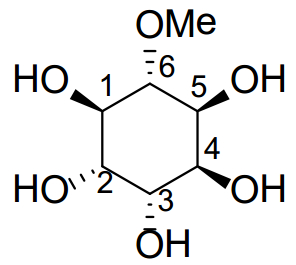
 DownLoad:
DownLoad: 



